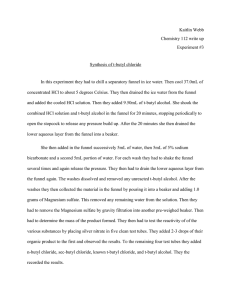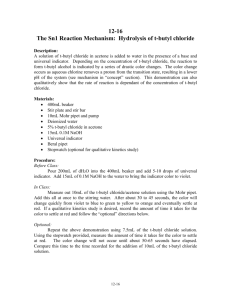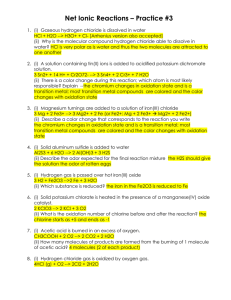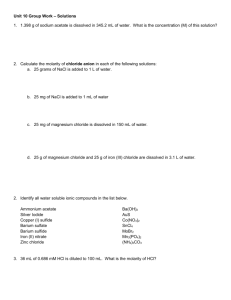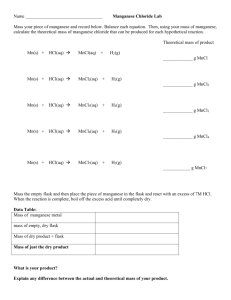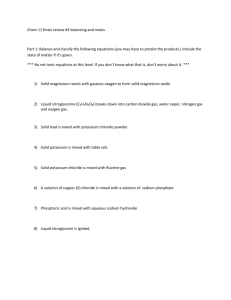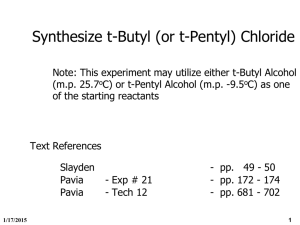The Hydrolysis of Tertiary-Butyl Chloride
advertisement
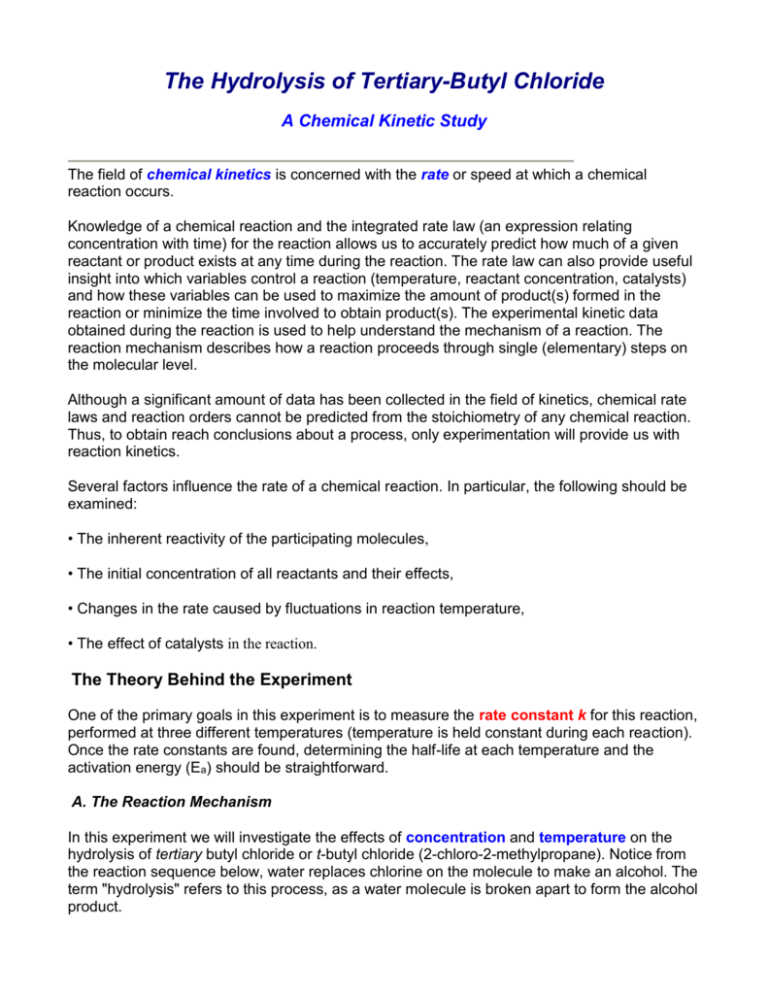
The Hydrolysis of Tertiary-Butyl Chloride A Chemical Kinetic Study The field of chemical kinetics is concerned with the rate or speed at which a chemical reaction occurs. Knowledge of a chemical reaction and the integrated rate law (an expression relating concentration with time) for the reaction allows us to accurately predict how much of a given reactant or product exists at any time during the reaction. The rate law can also provide useful insight into which variables control a reaction (temperature, reactant concentration, catalysts) and how these variables can be used to maximize the amount of product(s) formed in the reaction or minimize the time involved to obtain product(s). The experimental kinetic data obtained during the reaction is used to help understand the mechanism of a reaction. The reaction mechanism describes how a reaction proceeds through single (elementary) steps on the molecular level. Although a significant amount of data has been collected in the field of kinetics, chemical rate laws and reaction orders cannot be predicted from the stoichiometry of any chemical reaction. Thus, to obtain reach conclusions about a process, only experimentation will provide us with reaction kinetics. Several factors influence the rate of a chemical reaction. In particular, the following should be examined: • The inherent reactivity of the participating molecules, • The initial concentration of all reactants and their effects, • Changes in the rate caused by fluctuations in reaction temperature, • The effect of catalysts in the reaction. The Theory Behind the Experiment One of the primary goals in this experiment is to measure the rate constant k for this reaction, performed at three different temperatures (temperature is held constant during each reaction). Once the rate constants are found, determining the half-life at each temperature and the activation energy (Ea) should be straightforward. A. The Reaction Mechanism In this experiment we will investigate the effects of concentration and temperature on the hydrolysis of tertiary butyl chloride or t-butyl chloride (2-chloro-2-methylpropane). Notice from the reaction sequence below, water replaces chlorine on the molecule to make an alcohol. The term "hydrolysis" refers to this process, as a water molecule is broken apart to form the alcohol product. The reaction of t-butyl chloride with water proceeds as shown in the two-step reaction below: Combining steps (1) and (2), we find the overall reaction shown below. Notice that t-butyl alcohol and hydrochloric acid are the two products. The reaction rate for this process can be expressed as either the disappearance of t-BuCl or the appearance of t-BuOH (see equation below). Referring back to the overall net equation, HCl is also a product. Because of our familiarity with measuring acid strength (pH) in the lab, monitoring the appearance of HCl during the reaction would be the most convenient method to study kinetic changes during the reaction. Measuring the pH of the reaction can be done easily with a pH meter residing in the flask during reaction (recall that pH= - log [H+]). B. The Rate Law for t-BuOH Because step (2) in the reaction mechanism is faster than step (1), step (1) determines the rate of reaction (step (1) is the RDS or rate determining step). Step (1) is unimolecular, meaning the rate for that reaction depends only upon the concentration of the t-BuCl. Any unimolecular reaction is also a first-order reaction. Thus, the rate law for a first-order reaction is: (notice the last expression is a form of first order integrated rate law) As the overall reaction indicates, for every mole of t-BuCl consumed in the reaction, one mole of HCl is produced (i.e. 1 mole of H+ and 1 mole Cl-). Therefore, the number of moles of HCl produced during the course of the reaction is a measure of the number of moles of t-BuCl reacting. Understand that not every molecule of t-BuCl reacts in this process, so monitoring [HCl] is crucial to determining [t-BuCl]t. Using the integrated rate law for the first order process, we can easily find the initial concentration of t-BuCl in the reaction. Experimentally, things are not quite this simple. C. Adjusting for Water - Finding [t-BuCl]t Water is used as a reactant and part of the solvent system in this reaction (its reaction order is zero, meaning [H2O] has no effect on the rate and is essentially constant). As time approaches infinity, the moles of t-BuCl approaches zero and the moles of HCl produced approaches a maximum. By titrating the resulting solution after 48 hours, a good approximation of the initial amount of t-butyl chloride can be made. Experimentally time starts when the t-BuCl is added to the solvent mixture. At any time, the number of moles of HCl produced in the reaction equal to the total number of moles of t-BuCl consumed in the reaction. n HCl produced nt BuCl reacted Reaction Mechanism The hydrolysis involves 3 steps: 1. the ionization of the t-butyl chloride to form a carbocation intermediate; 2. the formation of a high energy transition state between the carbocation and water; 3. the formation of product, t-butyl alcohol by a hydrogen ion leaving the transition state complex. Virtual Models The reactants and intermediates related to the kinetics experiment, showing the various geometries of the molecules involved the hydrolysis of t-butyl chloride, (C=gray, H=white, Cl=green, O=red), Molecules can be viewed on-line at the following link. http://fp.academic.venturacollege.edu/doliver/chem12B/lab/kinetics_molecules.htm To see other formats such as space-filling models, right click your mouse button while on the picture. Choose another view under the Display submenu. Half-Life A useful parameter of rate equations, particularly first-order reactions, is the half-life or t1/2. The half-life is simply the time it takes for the reactant concentration in a reaction to reduce by 50%. For example, if we begin a reaction with a 0.20 M solution, then in one half-life the reaction will reduce to 0.10 M over a specific time frame, t1/2. In a second half-life, the reaction reduces another 50% to 0.05 M. Half-life for a reaction process is dependent on the reaction order. First the first order process, the t1/2 is independent on reactant concentration but dependent on the rate constant k : Note: k is temperature-dependent, and so the half-life for a reaction will change with the temperature. You should obtain 3 half-lives for this kinetic study. Activation Energy - The Arrhenius Equation The rate of a chemical reaction varies directly with temperature. This is understandable in terms of the frequency and productivity of collisions between the species in a reaction. The higher the kinetic energy (directly related to T), the greater the number of collisions. Svante Arrhenius proposed the following mathematical relationship for this phenomenon: • k = the rate constant of the reaction • A = the frequency factor (unitless) • Ea = activation energy (usually in kJ/mol) • R = ideal gas constant (usually 8.314 x 10-3 kJ/mol • K) • T = temperature in kelvins Taking the natural logarithm of both sides of the equation gives you: The bottom equation allows you to compare the data from reactions run at different temperatures in order to determine values for A and Ea. Yes, you should be thinking graphically. Procedure Set up the reaction vessel as shown at right. To prepare a temperature-controlled reaction flask, place a small Erlenmeyer Flask (reaction flask) into a large beaker (temperature bath) as shown in the figure. Accurately measure 50 mL of the 50% water/50% isopropyl alcohol v/v mixture and place into the flask. You will perform one run at 10°C and one run at 40°C. It is imperative that the temperature remains constant during the run, since k is extremely temperature dependent (see the Arrhenius equation). Add 5 drops of phenolphthalein to the flask. Allow the temperature bath (beaker) and reaction flask (Erlenmeyer) to come to thermal equilibrium (about 10 minutes) Temperature control is essential for this experiment. To ensure a constant temperature during the reaction, the solution level in the reaction flask should be well BELOW the water level in the temperature bath (beaker). You will need to add ice or hot water in small quantities to control the bath temperature within ±1°C. Use a magnetic stirrer with stir bars in the outer beaker and in the reaction flask. It is often useful to one member of the pair to maintain the constant temperature bath and record times, while the other member titrates the reaction mixture and notes times of each color change. While waiting for thermal equilibrium, clean a burette and fill with .100M NaOH. Add 1.00ml of the NaOH to the flask containing the mixture of isopropyl alcohol and water. Prepare a data table in you notebook with two columns; ml Base Added and clock time for color disappearance. If you don’t know how to use a pipette bulb, PLEASE ASK before you mess up!!! Place 1.00ml of t-BuCl into the flask and record the time. This marks t=0. Record the clock time required for the pink color to disappear. As soon as the pink color disappears, add another 1.00 ml of base, and again, note the time required for the pink color to disappear. Continue the addition of base and timing until the color remains pink. Stopper and label the bottle as 10°C. Set aside for the next lab period. Repeat the process for 40°C. Have a Bunsen burner, hot water and some ice available to maintain the temperature at 40±1°C. When finished, stopper and label the bottle as 40°C. Set aside for the next lab period. (At the instructor’s option a third run of 25°C will be run.) During the next lab period, titrate to a phenolphthalein end point with what ever is required (acid or base) to verify the initial moles of t-butyl chloride, and do lab calculations. Important things to note: 1. Record your CLOCK times to the nearest second. You will have time to convert to seconds after the data collection period. 2. Position the thermometer in the water bath so that the magnetic stir bar does not strike it while spinning. 3. Make sure that you are ready to take data before adding t-BuCl. When everything is ready, use a pipet to add 1.00 mL of the t-BuCl. Note that the total volume of solution will be 51.0 mL. 4. As soon as the first drops of t-BuCl enters the reaction vessel, the reaction has been initiated. This is time t=0 and you should immediately begin collecting data. If you miss a color change, QUICKLY add an additional 1.00 ml of base and make note of the volume change. Data Processing and Calculations The values to be determined from this experiment are: • the rate constants, k, for each temperature performed • the corresponding half-life, t1/2, for each temperature • the Arrhenius-derived A and Ea for the reaction. You will be producing several plots ([t-BuCl] vs. time and ln [t-BuCl] vs. time for both reaction temperatures + Arrhenius plot). You may wish to overlay the concentration plots on one graph to save space. It also affords a direct comparison between the graphs. You will use Excel to process and plot the data. Your spread sheet can be set up something like this. NOTE: The initial moles of t-butyl chloride must be calculated based on the total moles of base added at t = infinity or a couple of days, which ever comes first. This is calculated using the volume of base added during the timing portion of the experiment plus the volume of base used to titrate to the end point multiplied by the molarity of the base. Clock Time in time to seconds color to color mL change change M Base base 7:55:20 0 0.1 0 7:58:26 126 0.1 1 8:02:01 etc 0.1 2 etc etc 0.1 3 etc etc 0.1 4 Total Volume in liters 0.051 0.052 0.053 0.054 0.055 Moles Moles Moles t-butyl t-butyl [t-butyl Cl] base chloride chloride in added reacted remaining molarity ln[t-butyl Cl] 0 0 0.009103 0.178484 -1.7232543 0.0001 0.0001 0.009003 0.173129 -1.7537189 0.0002 0.0002 0.008903 0.167976 -1.783937 0.0003 0.0003 0.008803 0.163013 -1.8139252 0.0004 0.0004 0.008703 0.158231 -1.8436996 To make a graph, hold the control key down and click the columns you with to graph such as time and ln[t-BuCl]. Plot the data as a Scatter Plot. Add a trendline to each data set, displaying the equation and linear regression value (r2). From the plot, obtain the rate constant k. With the plots handy for different reaction temperatures, you should have two or three different values of k for the t-BuCl reaction. Construct an Arrhenius plot, using your k values. You must include the data from the other members of your cluster to increase the number of data points for statistical validity. Your instructor may ask you to use more. Once the Arrhenius plot is complete, determine the activation energy Ea (in kJ/mole) and frequency factor A (a unit-less quantity).

